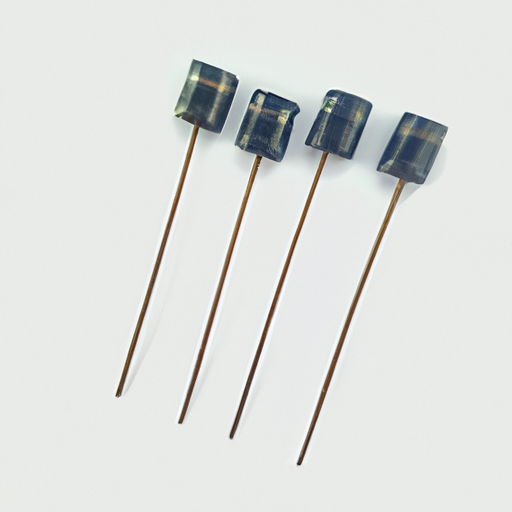What are the Popular Resistor Box Product Types?

I. Introduction
A. Definition of Resistor Boxes
Resistor boxes, also known as resistor networks or resistor banks, are essential tools in electronics that allow users to easily manage and manipulate resistance values in various circuits. These devices consist of multiple resistors housed in a single unit, enabling quick adjustments and testing without the need for individual resistors.
B. Importance of Resistor Boxes in Electronics
In the world of electronics, precision and flexibility are paramount. Resistor boxes play a crucial role in prototyping, testing, and educational settings, where varying resistance values are often required. They simplify the process of creating circuits, allowing engineers and hobbyists to experiment with different configurations without the hassle of soldering or replacing individual components.
C. Overview of the Article
This article will explore the various types of resistor boxes available on the market, their functionalities, applications, and key features to consider when selecting one. Additionally, we will discuss popular brands and models, as well as the applications of resistor boxes in different fields.
II. Types of Resistor Boxes
A. Fixed Resistor Boxes
1. Description and Functionality
Fixed resistor boxes contain a set of resistors with predetermined values. Users can select a specific resistance by connecting the appropriate terminals. These boxes are straightforward and easy to use, making them ideal for basic applications.
2. Common Applications
Fixed resistor boxes are commonly used in educational settings, basic circuit testing, and prototyping where specific resistance values are needed without the need for adjustments.
3. Advantages and Disadvantages
**Advantages:**
- Simplicity of use
- Cost-effective
- Reliable for fixed applications
**Disadvantages:**
- Limited flexibility
- Cannot adjust resistance values on-the-fly
B. Variable Resistor Boxes
1. Description and Functionality
Variable resistor boxes, also known as rheostats or potentiometers, allow users to adjust the resistance value continuously. This feature makes them versatile for applications requiring fine-tuning of resistance.
2. Common Applications
These boxes are often used in audio equipment, light dimmers, and other applications where variable resistance is essential for performance.
3. Advantages and Disadvantages
**Advantages:**
- Flexibility in resistance adjustment
- Ideal for applications requiring fine-tuning
**Disadvantages:**
- More complex than fixed resistor boxes
- Potential for wear and tear over time
C. Precision Resistor Boxes
1. Description and Functionality
Precision resistor boxes are designed for high accuracy and low tolerance levels. They are often used in laboratory settings where precise measurements are critical.
2. Common Applications
These boxes are commonly found in research and development labs, calibration processes, and high-precision testing environments.
3. Advantages and Disadvantages
**Advantages:**
- High accuracy and reliability
- Low tolerance levels
**Disadvantages:**
- Higher cost
- May be overkill for basic applications
D. Programmable Resistor Boxes
1. Description and Functionality
Programmable resistor boxes allow users to set resistance values through software or digital interfaces. This feature enables automation and integration into complex testing setups.
2. Common Applications
These boxes are often used in automated testing environments, robotics, and advanced prototyping where multiple resistance values are needed quickly.
3. Advantages and Disadvantages
**Advantages:**
- Automation capabilities
- Quick adjustments and settings
**Disadvantages:**
- Higher cost
- Requires technical knowledge to operate
E. Resistor Decade Boxes
1. Description and Functionality
Resistor decade boxes consist of multiple resistors arranged in decades (e.g., 1Ω, 10Ω, 100Ω, etc.). Users can combine these resistors to achieve a wide range of resistance values.
2. Common Applications
These boxes are popular in educational settings, laboratories, and testing environments where a variety of resistance values are needed.
3. Advantages and Disadvantages
**Advantages:**
- Wide range of resistance values
- Easy to use for various applications
**Disadvantages:**
- Bulkier than fixed resistor boxes
- May require manual calculations for specific values
III. Key Features to Consider When Choosing a Resistor Box
A. Resistance Range
The resistance range is a critical factor to consider. Depending on your application, you may need a box that covers a wide range of resistance values or one that focuses on specific increments.
B. Tolerance Levels
Tolerance indicates how much the actual resistance can vary from the stated value. For precision applications, look for resistor boxes with low tolerance levels.
C. Power Rating
The power rating indicates how much power the resistor box can handle without overheating. Ensure that the power rating meets the requirements of your application.
D. Size and Portability
Consider the size and weight of the resistor box, especially if you plan to use it in different locations or need to transport it frequently.
E. Connection Types
Different resistor boxes may offer various connection types, such as banana plugs, binding posts, or terminal blocks. Choose a box that is compatible with your existing equipment.
IV. Popular Brands and Models
A. Overview of Leading Manufacturers
Several manufacturers are known for producing high-quality resistor boxes, including:
Keysight Technologies: Renowned for precision instruments and testing equipment.
B&K Precision: Offers a range of resistor boxes suitable for educational and industrial applications.
Fluke: Known for reliable testing equipment, including resistor boxes.
B. Comparison of Popular Models
When comparing models, consider factors such as resistance range, accuracy, and user interface. For example, the Keysight 34470A offers high precision and a wide range of features, while the B&K Precision 8500 series provides a more budget-friendly option.
C. User Reviews and Feedback
User reviews can provide valuable insights into the performance and reliability of different resistor boxes. Look for feedback on ease of use, accuracy, and customer support.
V. Applications of Resistor Boxes
A. Educational Purposes
Resistor boxes are widely used in educational settings to teach students about electrical circuits, resistance, and Ohm's law. They provide a hands-on learning experience that enhances understanding.
B. Prototyping and Testing
Engineers and designers use resistor boxes during the prototyping phase to test circuit designs and make adjustments as needed. This flexibility can save time and resources.
C. Research and Development
In R&D environments, precision and accuracy are crucial. Resistor boxes enable researchers to conduct experiments with confidence, knowing they can rely on consistent resistance values.
D. Industrial Applications
In industrial settings, resistor boxes are used for testing and calibration of equipment, ensuring that systems operate within specified parameters.
VI. Conclusion
A. Summary of Key Points
Resistor boxes are invaluable tools in electronics, offering a range of functionalities to suit various applications. From fixed and variable resistor boxes to precision and programmable options, each type serves a unique purpose.
B. Future Trends in Resistor Box Technology
As technology advances, we can expect to see more sophisticated resistor boxes with enhanced features, such as improved connectivity options, integration with IoT devices, and greater automation capabilities.
C. Final Thoughts on Choosing the Right Resistor Box
When selecting a resistor box, consider your specific needs, including resistance range, tolerance, and application. By understanding the different types available and their respective advantages and disadvantages, you can make an informed decision that best suits your requirements.
VII. References
A. Citing Relevant Literature and Resources
- "The Art of Electronics" by Paul Horowitz and Winfield Hill
- Manufacturer websites for detailed specifications and user manuals
B. Additional Reading Suggestions
- Online forums and communities for user experiences and recommendations
- Educational resources on electronics and circuit design
This comprehensive overview of resistor boxes provides a solid foundation for understanding their types, features, and applications, helping you make informed choices in your electronic projects.
What are the Popular Resistor Box Product Types?

I. Introduction
A. Definition of Resistor Boxes
Resistor boxes, also known as resistor networks or resistor banks, are essential tools in electronics that allow users to easily manage and manipulate resistance values in various circuits. These devices consist of multiple resistors housed in a single unit, enabling quick adjustments and testing without the need for individual resistors.
B. Importance of Resistor Boxes in Electronics
In the world of electronics, precision and flexibility are paramount. Resistor boxes play a crucial role in prototyping, testing, and educational settings, where varying resistance values are often required. They simplify the process of creating circuits, allowing engineers and hobbyists to experiment with different configurations without the hassle of soldering or replacing individual components.
C. Overview of the Article
This article will explore the various types of resistor boxes available on the market, their functionalities, applications, and key features to consider when selecting one. Additionally, we will discuss popular brands and models, as well as the applications of resistor boxes in different fields.
II. Types of Resistor Boxes
A. Fixed Resistor Boxes
1. Description and Functionality
Fixed resistor boxes contain a set of resistors with predetermined values. Users can select a specific resistance by connecting the appropriate terminals. These boxes are straightforward and easy to use, making them ideal for basic applications.
2. Common Applications
Fixed resistor boxes are commonly used in educational settings, basic circuit testing, and prototyping where specific resistance values are needed without the need for adjustments.
3. Advantages and Disadvantages
**Advantages:**
- Simplicity of use
- Cost-effective
- Reliable for fixed applications
**Disadvantages:**
- Limited flexibility
- Cannot adjust resistance values on-the-fly
B. Variable Resistor Boxes
1. Description and Functionality
Variable resistor boxes, also known as rheostats or potentiometers, allow users to adjust the resistance value continuously. This feature makes them versatile for applications requiring fine-tuning of resistance.
2. Common Applications
These boxes are often used in audio equipment, light dimmers, and other applications where variable resistance is essential for performance.
3. Advantages and Disadvantages
**Advantages:**
- Flexibility in resistance adjustment
- Ideal for applications requiring fine-tuning
**Disadvantages:**
- More complex than fixed resistor boxes
- Potential for wear and tear over time
C. Precision Resistor Boxes
1. Description and Functionality
Precision resistor boxes are designed for high accuracy and low tolerance levels. They are often used in laboratory settings where precise measurements are critical.
2. Common Applications
These boxes are commonly found in research and development labs, calibration processes, and high-precision testing environments.
3. Advantages and Disadvantages
**Advantages:**
- High accuracy and reliability
- Low tolerance levels
**Disadvantages:**
- Higher cost
- May be overkill for basic applications
D. Programmable Resistor Boxes
1. Description and Functionality
Programmable resistor boxes allow users to set resistance values through software or digital interfaces. This feature enables automation and integration into complex testing setups.
2. Common Applications
These boxes are often used in automated testing environments, robotics, and advanced prototyping where multiple resistance values are needed quickly.
3. Advantages and Disadvantages
**Advantages:**
- Automation capabilities
- Quick adjustments and settings
**Disadvantages:**
- Higher cost
- Requires technical knowledge to operate
E. Resistor Decade Boxes
1. Description and Functionality
Resistor decade boxes consist of multiple resistors arranged in decades (e.g., 1Ω, 10Ω, 100Ω, etc.). Users can combine these resistors to achieve a wide range of resistance values.
2. Common Applications
These boxes are popular in educational settings, laboratories, and testing environments where a variety of resistance values are needed.
3. Advantages and Disadvantages
**Advantages:**
- Wide range of resistance values
- Easy to use for various applications
**Disadvantages:**
- Bulkier than fixed resistor boxes
- May require manual calculations for specific values
III. Key Features to Consider When Choosing a Resistor Box
A. Resistance Range
The resistance range is a critical factor to consider. Depending on your application, you may need a box that covers a wide range of resistance values or one that focuses on specific increments.
B. Tolerance Levels
Tolerance indicates how much the actual resistance can vary from the stated value. For precision applications, look for resistor boxes with low tolerance levels.
C. Power Rating
The power rating indicates how much power the resistor box can handle without overheating. Ensure that the power rating meets the requirements of your application.
D. Size and Portability
Consider the size and weight of the resistor box, especially if you plan to use it in different locations or need to transport it frequently.
E. Connection Types
Different resistor boxes may offer various connection types, such as banana plugs, binding posts, or terminal blocks. Choose a box that is compatible with your existing equipment.
IV. Popular Brands and Models
A. Overview of Leading Manufacturers
Several manufacturers are known for producing high-quality resistor boxes, including:
Keysight Technologies: Renowned for precision instruments and testing equipment.
B&K Precision: Offers a range of resistor boxes suitable for educational and industrial applications.
Fluke: Known for reliable testing equipment, including resistor boxes.
B. Comparison of Popular Models
When comparing models, consider factors such as resistance range, accuracy, and user interface. For example, the Keysight 34470A offers high precision and a wide range of features, while the B&K Precision 8500 series provides a more budget-friendly option.
C. User Reviews and Feedback
User reviews can provide valuable insights into the performance and reliability of different resistor boxes. Look for feedback on ease of use, accuracy, and customer support.
V. Applications of Resistor Boxes
A. Educational Purposes
Resistor boxes are widely used in educational settings to teach students about electrical circuits, resistance, and Ohm's law. They provide a hands-on learning experience that enhances understanding.
B. Prototyping and Testing
Engineers and designers use resistor boxes during the prototyping phase to test circuit designs and make adjustments as needed. This flexibility can save time and resources.
C. Research and Development
In R&D environments, precision and accuracy are crucial. Resistor boxes enable researchers to conduct experiments with confidence, knowing they can rely on consistent resistance values.
D. Industrial Applications
In industrial settings, resistor boxes are used for testing and calibration of equipment, ensuring that systems operate within specified parameters.
VI. Conclusion
A. Summary of Key Points
Resistor boxes are invaluable tools in electronics, offering a range of functionalities to suit various applications. From fixed and variable resistor boxes to precision and programmable options, each type serves a unique purpose.
B. Future Trends in Resistor Box Technology
As technology advances, we can expect to see more sophisticated resistor boxes with enhanced features, such as improved connectivity options, integration with IoT devices, and greater automation capabilities.
C. Final Thoughts on Choosing the Right Resistor Box
When selecting a resistor box, consider your specific needs, including resistance range, tolerance, and application. By understanding the different types available and their respective advantages and disadvantages, you can make an informed decision that best suits your requirements.
VII. References
A. Citing Relevant Literature and Resources
- "The Art of Electronics" by Paul Horowitz and Winfield Hill
- Manufacturer websites for detailed specifications and user manuals
B. Additional Reading Suggestions
- Online forums and communities for user experiences and recommendations
- Educational resources on electronics and circuit design
This comprehensive overview of resistor boxes provides a solid foundation for understanding their types, features, and applications, helping you make informed choices in your electronic projects.













